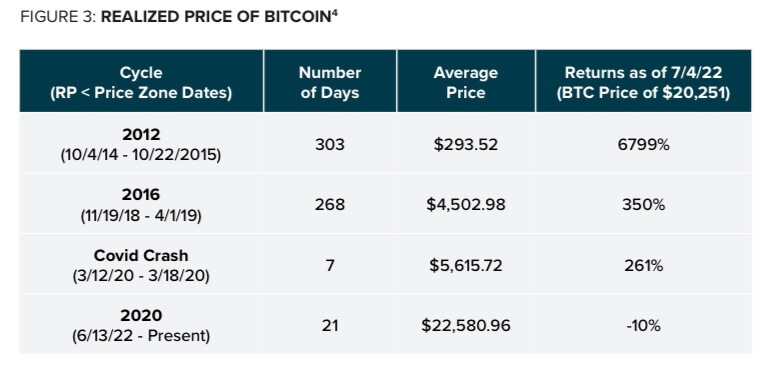
2023-7-6 13:32 |
I don’t like the term “the next bull market” when looking at cryptocurrency markets. Ditto for “crypto winter” and, worst of all, “if we look at previous cycles”.
Crypto may have cycled through violent ups and downs in the past, and it may do so in the future, but we need to be diligent with blanket assumptions that previous cycles will repeat. Take the below chart, for example, which superimposes the current Bitcoin price cycle (starting in 2021) onto the 2013-2017 cycle and the 2017-2021 cycle. Popular variants of this chart are often shared in the space and referenced as inevitable omens of future price appreciation.
It’s a seductive graph, and one that lights up the imagination of any Bitcoin holder once they see it. It’s easy to see how such analysis gains such traction (without even mentioning the already cult-like following that a lot of crypto garners).
However, there are a number of glaring problems with this, and with every other comparison of this nature. To be clear, I don’t think Bitcoin will never again ramp up as it has done in the past (I do), nor do I think previous cycles are completely irrelevant, but I think the forecasts and timing predictions derived from these prior cycles are often misguided, for three prominent reasons.
Sample sizeThe most basic and oft-violated principle in all of statistics is the sample size error. Bitcoin has scarcely been around a minute, the first block mined by the enigmatic Satoshi Nakamoto in January 2009, with the first exchange coming online in mid-2010. Are thirteen years of price data really enough to draw concrete conclusions from?
Not only that, but a big chunk of those thirteen years came when much of the financial world had no idea what this funny Internet money was, rendering much of its history largely irrelevant when assessing it today with respect to model-building or formulating predictions around future price movements. This brings us onto faux-pas number two…
LiquidityLiquidity in Bitcoin markets is currently very low. And that is today, in 2023. Going back five years, markets were even thinner, when Bitcoin was an extremely niche asset far from the mainstream stage. The asset’s graduation from cult plaything to bona-fide financial asset has come, as would be expected, with a whole range of infrastructure: from exchanges, to publicly-traded mining companies, to trusts (and maybe soon ETFs), and so on. With all this has come greater liquidity.
It therefore feels like an enormous reach to draw concrete conclusions from Bitcoin’s price movements prior to at least 2017. The halvening cycles are often referenced as benchmarks here, and while the sudden reduction in the release of new supply undoubtedly has an impact on the supply-demand relationship and therefore the price, so does the other side of that equation: demand.
I just struggle to see how the early days of Bitcoin’s trading history have much relevance to today, years during which 70%+ of trading was taking on one exchange (Mt Gox) and price was oscillating violently on a daily basis (not that that still doesn’t occur, as the next chart shows). Liquidity is one of the most important factors when determining the price of any asset, and Bitcoin’s liquidity has flipped dramatically in its short history thus far.
Liquidity was non-existent for a number of years. Can we really put weight into price movements from a period where one large buy order could throw up a massive green candle, or a couple of quick sales nuke the entire chart? For the first few years of Bitcoin’s trading history, that is precisely what happened.
The end of the greatest bull run in historyThe final factor which I believe is the most overlooked when assessing prior Bitcoin cycles is the following: Bitcoin has never before experienced a bear market in the wider economy.
Bitcoin was launched in January 2009, in the aftermath of the Great Financial Crash. A reference to bank bailouts is even contained within the code of the Genesis block mined by Satoshi Nakamoto.
Two months after this launch, and with Bitcoin not yet trading on a marketplace, the stock market bottomed out. Since then, until the peak prior to 2022, the S&P 500 multiplied 7X and the Nasdaq jumped 13X.
So, Bitcoin was launched into the perfect market environment: nearly exactly at the stock market bottom, ahead of one of the longest and most explosive bull markets in history, where nearly every asset under the sun rose in value.
Of course, one of the major underlying reasons for all this was interest rates. Rates were kept near zero for most of this period, facilitating cheap money and a tidal wave of appreciating risk-on assets. Bitcoin was on those assets to happily ride that wave.
And then came 2022. Rampant inflation emerged as a result of aggressive money printing, a once-in-a-lifetime pandemic, supply chain issues, and a war in Europe which choked the energy market. Central banks were forced to hike interest rates, ending the party emphatically. Not only that, but the rate hiking cycle has been the fastest in modern history, with rates now north of 5% in the US, the pause last month being the first time rates had not been hiked since March 2022.
Last year therefore represented the first time in Bitcoin’s short history that it experienced anything other than an effervescent bull market for risk assets. It is currently witnessing the concept of a (material) interest rate for the first time, too, with rates near-zero (or even negative) throughout the rest of its young life.
This contrasting macro climate has invalidated so many predictive models for Bitcoin, such as declarations of a “supercycle”, or Plan B’s stock-to-flow model (although I still am intrigued by the latter and believe it has interesting implications, but that is for another day). And it simply must be considered when drawing upon prior cycles to predict future price movements.
Final thoughtsThe point being, when we put all these factors together – the tiny sample size, the flip in liquidity, and the first high-interest / bear market environment of Bitcoin’s life – it highlights how much care needs to be taken when drawing upon Bitcoin’s past performance for the purpose of forecasting future price action.
Sure, there are interesting tidbits to be taken (and I utilise several in my analysis), but this is an asset that has literally transformed from an obscure experiment on a faraway corner of the Internet into a mainstream financial asset. Concurrently, the world economy has flipped in equally dramatic fashion, from the bone-shuddering GFC to the remarkable bull market to the black swan of all swans: the COVID pandemic.
For one last time, I am not for one second saying Bitcoin will not rise again, just like it has in the past. But to blindly pull patterns from past cycles without considering all that has happened since, and the environment during which those patterns occurred, feels misguided at best.
The post Beware naive extrapolation of previous Bitcoin cycles for crypto price predictions appeared first on Invezz.
origin »Emerald Crypto (EMD) на Currencies.ru
|
|













